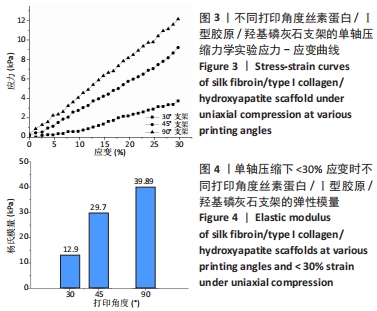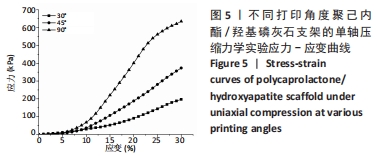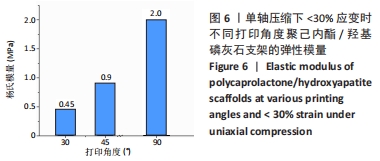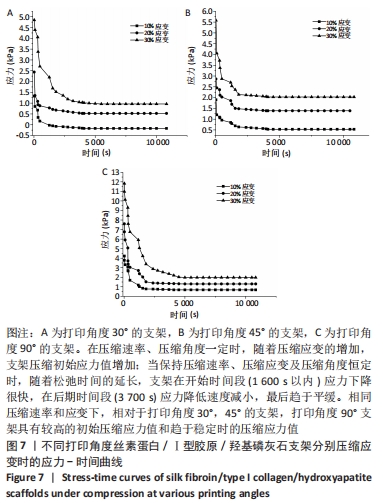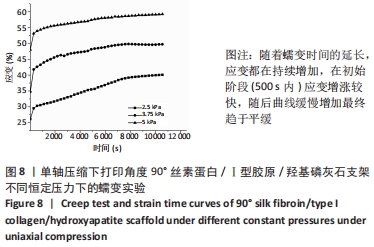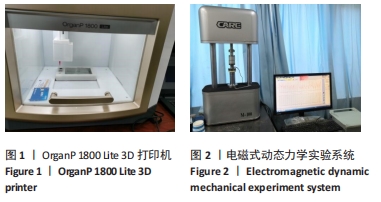中国组织工程研究 ›› 2022, Vol. 26 ›› Issue (22): 3550-3555.doi: 10.12307/2022.304
• 复合支架材料 composite scaffold materials • 上一篇 下一篇
基于低温3D打印丝素蛋白/Ⅰ型胶原/羟基磷灰石支架的力学性能
孟露露1,2,刘 浩3,刘 涵3,4,张 军3,李瑞欣3,高丽兰1,2
- 1天津理工大学,天津市先进机电系统设计与智能控制重点实验室,天津市 300384;2机电工程国家级实验教学示范中心(天津理工大学),天津市 300384;3南开大学附属口腔医院,天津市口腔医院,天津市口腔功能重建重点实验室,天津市 300041;4南开大学,天津市 300071
Mechanical properties of silk fibroin/type I collagen/hydroxyapatite scaffolds based on low-temperature 3D printing
Meng Lulu1, 2, Liu Hao3, Liu Han3, 4, Zhang Jun3, Li Ruixin3, Gao Lilan1, 2
- 1Tianjin Key Laboratory for Advanced Mechatronic System Design and Intelligent Control, School of Mechanical Engineering, Tianjin University of Technology; 2National Demonstration Center for Experimental Mechanical and Electrical Engineering Education (Tianjin University of Technology); 3the Affiliated Stomatological Hospital of Nankai University, Tianjin Stomatological Hospital, Tianjin Key Laboratory of Oral and Maxillofacial Function Reconstruction; 4Nankai University
摘要:
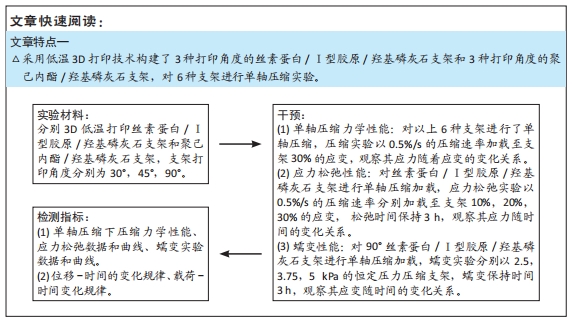
文题释义:
应力松弛:在总应变不变的条件下,由于黏弹性材料内部的黏性应变分量随时间不断增长,使回弹性应变分量随时间逐渐降低,从而导致变形恢复力随时间逐渐降低的现象。
蠕变:蠕变实验方法有很多种类,如通过对材料试件施加恒定的压力以研究材料压缩蠕变性能,还可以对材料施加恒定扭力以研究材料的扭转蠕变性能等。
背景:随着3D打印技术在组织工程的快速发展,通过3D打印制备出多种支架材料被广泛用于下颌骨缺损修复,3D打印技术为下颌骨缺损修复带来了新的可能。
目的:采用低温3D打印技术构建三维仿生骨支架材料,精确控制支架材料内部结构,并对其进行力学性能分析。
方法:在同等体积下,通过改变打印支架线束与线束的交错角度,采用低温3D打印技术分别打印不同角度(30°,45°,90°)的丝素蛋白/Ⅰ型胶原/羟基磷灰石支架与聚己内酯/羟基磷灰石支架(共6组支架)。单轴压缩力学实验以0.5%/s的压缩速率加载6组支架,压缩至30%的应变,观察应力随着应变的变化关系;应力松弛实验以0.5%/s的压缩速率分别加载至3种打印角度丝素蛋白/Ⅰ型胶原/羟基磷灰石支架10%,20%,30%的应变,松弛保持时间3 h,观察应力随时间的变化关系;蠕变实验分别以2.5,3.75,5 kPa的恒定压力压缩打印角度为90°的丝素蛋白/Ⅰ型胶原/羟基磷灰石支架,蠕变保持时间3 h,观察应变随时间的变化关系。
结果与结论:①单轴压缩力学实验:对于丝素蛋白/Ⅰ型胶原/羟基磷灰石支架和聚己内酯/羟基磷灰石支架,相同压缩应变下打印角度为90°支架的杨氏模量高于打印角度为30°,45°的支架。②应力松弛实验:当保持压缩速率、压缩应变及压缩角度恒定时,丝素蛋白/Ⅰ型胶原/羟基磷灰石支架的应力随松弛时间的延伸先快速降低,然后缓慢降低,随着松弛时间的延长,支架在开始时间段(1 600 s以内)应力下降很快,在后期时间段(3 700 s)应力降低速度减小,最后趋于平缓;当保持压缩速率、压缩应变恒定时,相对于打印角度为30°,45°的支架,打印角度为90°丝素蛋白/Ⅰ型胶原/羟基磷灰石支架的应力初值及趋于平稳时的应力值较高;当压缩速率及压缩角度恒定时,随着压缩应变值增加,丝素蛋白/Ⅰ型胶原/羟基磷灰石支架的应力值增加。③蠕变实验:随着蠕变时间的延长,90°的丝素蛋白/Ⅰ型胶原/羟基磷灰石支架的应变增加,在初始阶段(500 s内)应变增涨较快,随后应变缓慢增加最终趋于平缓,2.5 kPa下支架的应变变化范围为35%到55%,3.75 kPa下支架的应变变化范围从43%到57%,5 kPa下支架的应变变化范围从45%到57%。
https://orcid.org/0000-0003-3758-0910 (孟露露) ;https://orcid.org/0000-0002-7288-6686 (高丽兰)
中国组织工程研究杂志出版内容重点:生物材料;骨生物材料; 口腔生物材料; 纳米材料; 缓释材料; 材料相容性;组织工程
中图分类号:
